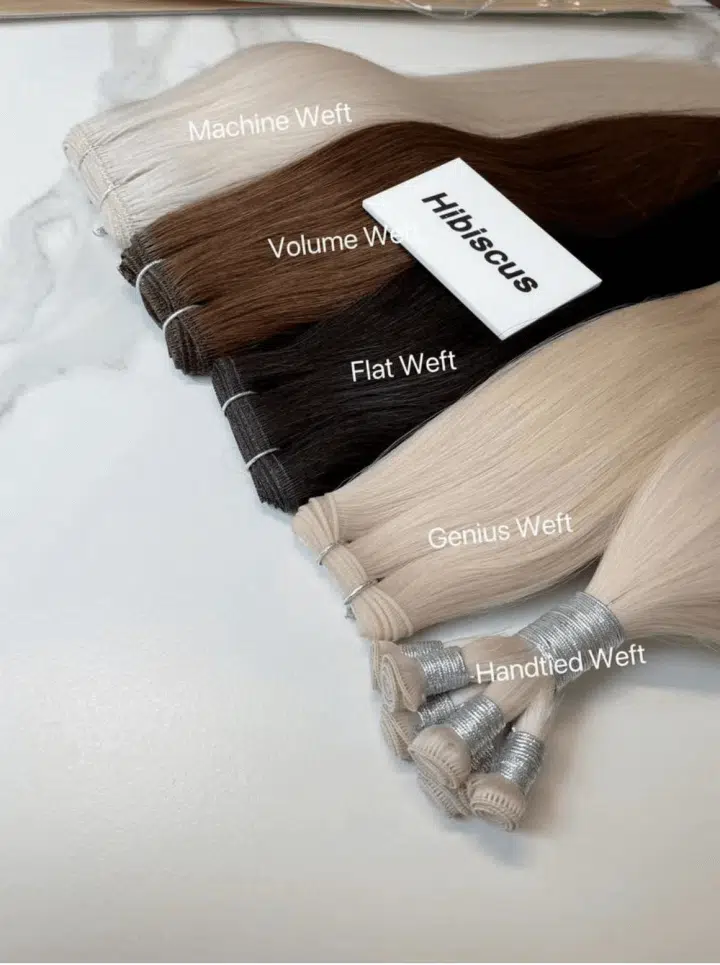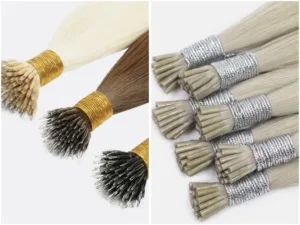As hair wefts are a staple in the hair extension market, with a wide array of types and specifications, choosing the right Chinese factory for your brand is crucial. This guide provides essential insights into the wholesale weft hair extensions market in China, helping you make informed decisions for your brand.
For successful wholesale of weft hair extensions from China, first, identify reliable manufacturers. Next, conduct detailed factory audits, focus on hair quality, ethical sourcing, and processing methods to ensure products meet your brand’s standards. including selecting the appropriate weft types, tailoring products to meet current market trends and client needs, and navigating the logistics and quality assurance processes after arrival to guarantee a successful import journey.
Stay with us as we delve deeper into the process of successfully importing hair wefts from China, exploring the finer details that make all the difference in this intricate process.

Identifying Trustworthy Manufacturers for Weft Hair Extensions
Manufacturer lists
Online Platforms: Utilize Google for extensive lists of manufacturers specializing in weft hair extensions.
Industry Publications and Forums: Consult trade magazines, online forums, and social media groups focused on hair extensions for insights and manufacturer recommendations.
Industry Networks: Seek advice from industry peers, particularly those experienced in importing similar products.
Trade Events: Visit important trade shows and beauty expos, like Cosmoprof Worldwide Bologna or the China Beauty Expo, to meet manufacturers and see their products showcased.
Conducting Factory Audits:
Site Visits: Undertake on-site visits to assess production areas, storage facilities, and overall work environments.
Ethical and Environmental Standards: Confirm the manufacturer’s compliance with labor laws, ethical practices, and environmental standards.
Live Demonstrations: Request demonstrations of the weft hair extension production process to gauge craftsmanship and technological input.
Establishing Communication:
Assessing Hair Quality
When specifying product requirements for weft hair extensions, it’s essential to focus on hair quality, which directly impacts the end product’s look, feel, and durability. Here are key aspects to consider and discuss with manufacturers:
1、Hair Quality:When discussing hair quality with manufacturers, it’s crucial to confirm the specific types of hair they offer. Virgin Hair, Remy Hair, or Full Cuticle Hair, This is to ensure alignment with the quality standards of your brand, ensuring customer satisfaction and brand integrity.
2、Hair Processing:When discussing processing with manufacturers, it’s important to delve into their production methods, This could involve questions about the duration of treatments, temperatures used, and measures taken to preserve hair integrity during processing.leveraging your professional knowledge and experience to ensure their processes align with your product requirements.
3、Ethical Sourcing: Confirm the ethical sourcing of the hair. It’s important that the hair is sourced responsibly and ethically, respecting both the donors and environmental guidelines.
4、Batch Consistency: Inquire about the measures taken to ensure consistency in hair quality across different batches. Consistency is key to maintaining a reliable standard for your brand.
Quality Control Measures: Understand their quality control processes, including how they sort, grade, and prepare the hair before it becomes a finished product.
By focusing on these detailed aspects of hair quality, you can ensure that the weft hair extensions you import align with your brand’s quality standards.

Product Specifications and Customization Options
1、Product kinds: Identifying the Types of Hair Wefts Required
When planning to import hair wefts, it’s crucial to identify and understand the various types available in the market. Different brands may use varied naming conventions, but most manufacturers are capable of producing these common types:
Machine Weft Hair Extensions: These are made by sewing strands of hair together with a sewing machine, creating a track-like effect. They are known for their durability and are one of the most commonly available types.
Hand-Tied Wefts: As the name suggests, these wefts are hand-made by tying strands of hair onto a hair track. They are thinner and lay flatter against the scalp compared to machine wefts, offering a more natural look.
Genius Wefts: These are a hybrid between machine weft and hand-tied weft. They mimic the appearance of hand-tied wefts but are produced with a machine, making them more cost-effective while still offering a similar aesthetic.
Flat Weft Hair Extensions: These wefts are designed to be ultra-thin and flexible, providing a comfortable and seamless experience for the wearer. They can be cut to size without unraveling, which is a significant advantage.
PU Weft Extensions: These feature a thin, polyurethane coating at the top of the weft, making them durable and flexible. They are often used for people with thinner hair due to their flat and seamless application.
Volume Wefts: Specifically designed to add volume, these wefts are thicker and have more hair attached to them. They are ideal for those looking to add significant fullness to their hair.
The above are the main types of hair wefts currently on the market,each of these weft types has its unique features and benefits. When communicating with manufacturers, it’s important to specify the exact type of weft hair extensions and tell them the effect you expect.

2、Product Specifications: Length and Weight Based on Weft Type
When specifying product requirements for weft hair extensions, it’s important to discuss the length and weight specifications, as these can vary significantly based on the type of weft. Tailoring these specifications to your brand’s needs and confirming the manufacturer’s ability to produce them are crucial steps.
3、Customization Options: Adapting Products to Market Trends and Client Needs
When discussing customization options with manufacturers, it’s essential to explore their flexibility and innovative capabilities in adapting products to current market trends and specific client requirements. This involves delving into various aspects:
Color Matching Services: Ensure the manufacturer has the capability to accurately match colors based on your specifications, which is crucial for maintaining brand consistency and meeting customer expectations.
Diverse Texture Options: Explore the possibility of offering a range of text ures, from straight to wavy to curly, catering to a diverse clientele. This includes the ability to replicate specific textures accurately and consistently.
Adaptability to Trends: Assess the manufacturer’s ability to quickly adapt to changing market demands and trends, enabling your brand to stay competitive and relevant.

Additional Considerations:
Logistical Efficiency: Evaluate their capacity to handle large orders and adapt to changes in demand while meeting delivery schedules.
After-Manufacture Services:
Customer Support: Assess their level of customer service, including responsiveness and communication efficiency.
Warranty and Returns: Discuss their policies on warranties, returns, and handling defective items.

Sample and Formal Orders for Weft Hair Extensions
Key areas of testing for weft hair extensions.
As the variety of hair wefts in the market is extensive, each type requires specific focus points during testing to ensure they meet the desired quality standards. Understanding these main nuances is crucial for successful product sourcing.
Durability and Weft Construction:
Stress Tests: Conduct comprehensive stress testing to evaluate the resilience of different weft types under various conditions, assessing their longevity and durability.
Weft Integrity: Inspect each weft type for stitching quality and overall build, paying attention to potential weaknesses such as shedding or material deterioration that may vary across weft styles.

Color Specifications:
Color Matching: Test each weft type for color alignment with your brand’s color ring and fashion shades, using precise color tools for accurate matching.
Color Fastness: Assess color longevity and uniformity for all weft types, with particular emphasis on their resistance to common factors like washing and sunlight.
Weft Adhesion and Strength:
Bonding Tests: Some hair wefts use glue to produce, so evaluate the bonding strength of each weft, ensuring it maintains structural integrity under different conditions, including temperature variations and humidity levels.
Hair Shedding Prevention: Conduct tests on each weft type to ensure hair is securely held, preventing shedding under various environmental and stress conditions.
Comfort and Wearability:
Wear Testing: Perform wear tests for each weft type to assess comfort levels during prolonged use, focusing on factors like weight, flexibility, and scalp irritation.
Adaptability: Examine how each weft type adapts to various hair types and styling needs, ensuring they integrate seamlessly and comfortably.
Lifespan and durability:
Durability Under Normal Use: Observe how long the hair maintains its quality and appearance during regular use or testing conditions. This is crucial to ensure that the lifespan of the hair aligns with your brand’s positioning and marketing claims.
Consistency with Brand Promise: Validate that the hair’s durability matches the expectations set by your brand’s promise, ensuring customer satisfaction and maintaining brand integrity.
Hair Quality Checks:
Natural Appearance: Confirm the natural appearance and blend of the hair in each weft type with different hair types.
Hair Strength: Assess the hair strength for each weft type, ensuring it withstands regular use without significant degradation.
Reusability and Maintenance:
Long-Term Performance: Evaluate how well each weft type maintains its quality after repeated applications and removals.
Care Requirements: Determine the specific maintenance and care needed for each weft type to keep them in optimal condition.

Regular Sampling and Feedback:
Sampling Strategy: Adapt your sampling strategy to cover the specific testing needs of each weft type, determining the frequency and proportion of batch sampling.
Feedback System: Develop a detailed feedback mechanism tailored to each weft type, allowing for continuous quality improvement and effective problem-solving with the manufacturer.
Transitioning Plan: Establish a timeline for transitioning from sample orders to formal orders based on the quality consistency observed in the sample tests for each weft type.
Gradual Increase in Order Size: Start with smaller order sizes during the initial sampling phase, gradually increasing as the manufacturer consistently meets quality standards.
Evaluation Period: Set a clear evaluation period, such as 6-12 months, during which sample quality is assessed before transitioning to larger, formal orders.
Performance-Based Transition: Make the transition to formal orders contingent on the manufacturer’s ability to meet predetermined quality benchmarks consistently over the evaluation period.

Transitioning to Formal Orders:
Quality Assurance: Work with third-party quality control firms to conduct unbiased audits for each weft type, establishing a comprehensive batch quality check protocol.
Negotiation Strategies: Utilize your order volume strategically for favorable pricing, ensuring flexibility in the order system to adapt to market demands for different weft types.
Contractual Details: Ensure that contracts comprehensively cover the specifications of each weft hair extension type, including length, color, texture, quality, and brand-specific requirements.
Long-Term Partnerships: Aim to develop lasting relationships with manufacturers, focusing on mutual understanding, reliability, and the potential for future collaborations that cater to the specific needs of different weft types.
By expanding on these aspects, you ensure a thorough and tailored approach to sampling and ordering for various types of wefts.
Mastering Logistics and Post-Arrival Quality Checks for Weft Hair Extensions
Freight Options:
Air Freight Benefits: Given their high value and low weight, air freight is typically the most efficient shipping method for weft hair extensions, providing faster transit times and reduced handling risk.
Document Preparation:
Detailed Documentation: Accurately fill out all shipping documents, including the Bill of Lading, Commercial Invoice, and Packing List, detailing the product’s specifications, quantity, and value.
Compliance Documentation: Prepare necessary compliance documents for customs, like safety certifications or import licenses.
Customs Duties and Regulations:
Duty Calculation: Familiarize yourself with tariff codes and duty rates for hair extensions in your country for accurate customs duty calculations.
Regulatory Compliance: Ensure compliance with all import regulations and standards, which may include specific health and safety regulations for hair products.
Post-Arrival Quality Checks:
Random Sampling: Select a random sample of the hair extensions upon arrival for comprehensive testing, including checks for color, texture, bonding quality, and overall integrity.
Consistency Verification: Compare the arrived batch with your original quality standards and sample orders to ensure consistency.

Defect Management:
Immediate Documentation: Document any discrepancies or defects upon discovery with photographs and detailed descriptions.
Prompt Communication: Notify the manufacturer immediately to discuss the issues, potential causes, and remedies, which may include returns, replacements, or adjustments in future orders.
Efficient Distribution:
Inventory Management: Implement an effective inventory management system for smooth distribution.
Warehouse Strategy: Strategically place warehouses to optimize logistics, reducing delivery times and costs to various markets.
Marketing and Sales:
Target Market Identification: Understand your target market, focusing on professional hair salons, stylists, and hair extension retailers.
Promotional Efforts: Develop marketing campaigns that highlight the unique qualities of your weft hair extensions, such as their ease of use, versatility in color and style, and durability.
Customer Relationship Management:
After-Sales Support: Provide outstanding after-sales service, including installation guides, care tips, and responsive customer support.
Feedback Collection: Regularly collect and analyze customer feedback to continuously improve your product and service offerings.
Brand Development:
Quality Reputation: Use the high quality of your weft hair extensions to build a strong brand reputation in the market.
Influence and Partnerships: Collaborate with influencers, stylists, and salons to increase brand visibility and credibility.

CONCLUSION
Successfully wholesaling weft hair extensions from China requires a careful selection of manufacturers, a deep understanding of product types and specifications, and efficient logistics management. This guide equips you with the essential knowledge and actionable steps to source high-quality extensions that align with your brand values and meet your clientele’s expectations. Hope you have a great journey in importing hair extensions from Chinese manufacturers!




